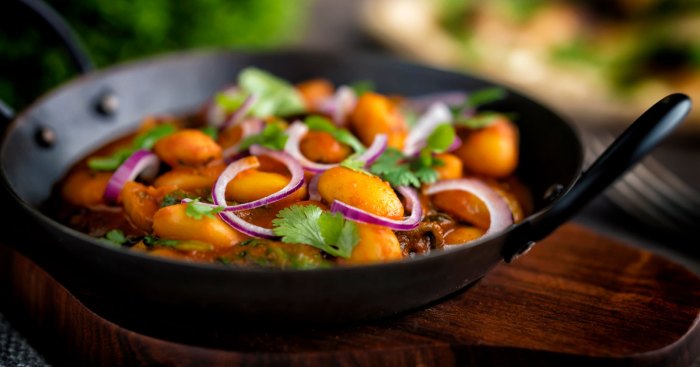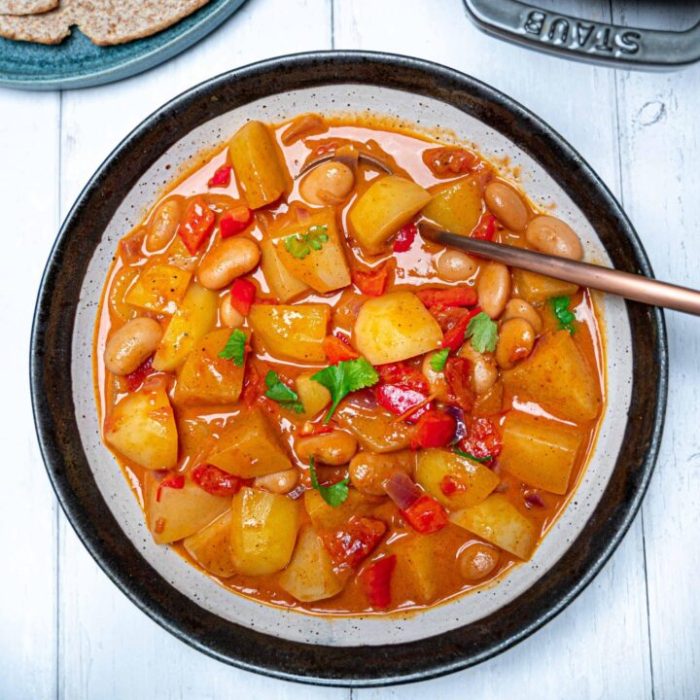Embark on a culinary journey with butter bean curry, a delectable dish that tantalizes taste buds and nourishes the body. This versatile curry showcases the harmonious blend of spices, herbs, and wholesome ingredients, offering a symphony of flavors and an abundance of nutritional benefits.
Ingredients
Butter bean curry is a versatile dish that allows for creativity and customization based on personal preferences and regional influences. Here is a comprehensive list of ingredients commonly used in butter bean curry, along with their roles and significance:
Beans, Butter bean curry
- Butter beans:These are the star ingredient, providing a creamy and nutty base for the curry. They are rich in protein and fiber, contributing to the dish’s nutritional value.
- Other beans:Variations of the curry may include other types of beans, such as chickpeas or kidney beans, adding diversity to the texture and flavor profile.
Vegetables
- Tomatoes:They add a vibrant red color, tangy flavor, and acidity to balance the richness of the beans.
- Onions:They provide a sweet and aromatic base, caramelizing as they cook and adding depth to the curry.
- Garlic and ginger:These aromatic ingredients are essential for building a flavorful foundation for the curry, adding a pungent and warming touch.
- Green chilies:They bring a subtle heat to the dish, adding a spicy kick that can be adjusted to personal preferences.
- Other vegetables:Optional additions like carrots, bell peppers, or peas can add color, texture, and nutritional value to the curry.
Spices
- Turmeric:This vibrant yellow spice imparts a warm, earthy flavor and adds a beautiful golden hue to the curry.
- Cumin:Its warm, nutty flavor complements the beans and vegetables, adding a depth of flavor.
- Coriander:This citrusy and earthy spice brings a fresh and fragrant aroma to the dish.
- Red chili powder:It adds heat and spiciness, balancing the richness of the curry.
- Garam masala:This aromatic blend of spices, often including cinnamon, cloves, cardamom, and nutmeg, adds a complex and exotic flavor.
Herbs
- Cilantro:Its fresh, citrusy flavor adds a vibrant and herbaceous touch to the curry.
- Other herbs:Variations may include mint, basil, or thyme, adding freshness and complexity to the dish.
These ingredients come together to create a flavorful and satisfying butter bean curry, with each element contributing to its unique taste and texture. Feel free to experiment with different combinations and adjust the proportions to suit your preferences.
Cooking Methods
Butter bean curry can be prepared using various cooking methods, each with its advantages and disadvantages. These methods include stovetop, slow cooker, and pressure cooker.
The stovetop method is straightforward and allows for precise control over the cooking process. It is suitable for smaller batches and requires constant monitoring to prevent burning or overcooking. On the other hand, the slow cooker method is ideal for larger batches and provides a more hands-off approach.
The extended cooking time allows the flavors to develop fully, but it may require additional time to prepare the ingredients.
Stovetop Method
- Heat oil in a large pot or Dutch oven over medium heat.
- Add the onions and cook until softened, about 5 minutes.
- Add the garlic, ginger, and spices and cook for 1 minute more.
- Stir in the tomatoes and cook for 5 minutes, or until softened.
- Add the butter beans, coconut milk, and vegetable broth.
- Bring to a boil, then reduce heat and simmer for 30 minutes, or until the beans are tender.
- Stir in the cilantro and serve over rice.
Flavor Profiles
Butter bean curry boasts a diverse array of flavor profiles, a testament to its versatility and adaptability. The interplay of spices, herbs, and other ingredients creates a harmonious symphony of flavors that tantalizes the palate.
Regional cuisines and cultural preferences exert a profound influence on the flavor variations of butter bean curry. In India, the birthplace of this dish, it is typically characterized by a vibrant blend of spices such as turmeric, cumin, coriander, and chili powder, resulting in a warm and aromatic flavor profile.
In the Caribbean, butter bean curry often incorporates coconut milk, imparting a rich and creamy sweetness. Meanwhile, in Southeast Asia, lemongrass, galangal, and kaffir lime leaves add a refreshing and citrusy dimension.
Key Flavor Notes
Several key flavor notes converge to create the distinctive taste experience of butter bean curry. Heat, provided by chili peppers or spices like cayenne, adds a fiery kick that balances the sweetness and acidity of other ingredients. Sweetness, often derived from onions, tomatoes, or coconut milk, tempers the heat and provides a comforting warmth.
Acidity, introduced through ingredients like tamarind or lemon juice, adds a refreshing tang that brightens the overall flavor profile. Finally, umami, a savory and meaty flavor, is imparted by the beans themselves, as well as ingredients like mushrooms or soy sauce.
Nutritional Value

Butter bean curry offers an array of nutritional benefits, making it an excellent choice for a balanced and healthy meal. It is a rich source of protein, fiber, vitamins, and minerals, each contributing to overall well-being.
The beans themselves are a substantial source of protein, essential for building and repairing tissues, and providing a feeling of satiety. Additionally, they are rich in fiber, which aids in digestion, regulates blood sugar levels, and promotes a healthy weight.
Role of Ingredients
- Beans:Protein, fiber, iron, folate
- Vegetables:Vitamins A, C, K, fiber, antioxidants
- Spices:Anti-inflammatory properties, antioxidants, flavor
The vegetables in the curry, such as tomatoes, onions, and peppers, provide a range of vitamins, including vitamin A for vision, vitamin C for immune function, and vitamin K for blood clotting. The spices used, such as turmeric and cumin, not only enhance the flavor but also contribute antioxidants and anti-inflammatory properties.
Portion Sizes and Calorie Content
A moderate portion of butter bean curry, approximately 1 cup, provides around 250-300 calories. It is important to pair the curry with a balanced meal, including whole grains and lean protein, to ensure a complete range of nutrients.
Accompaniments

Butter bean curry, with its rich and flavorful profile, pairs well with various accompaniments that complement its taste and texture. Traditional accompaniments like rice, roti, or naan provide a starchy base that balances the curry’s intensity. Rice, with its neutral flavor, allows the curry’s flavors to shine through, while roti or naan, with their slightly chewy texture, offer a satisfying contrast to the creamy beans.
Innovative Accompaniments
Beyond traditional accompaniments, butter bean curry can be paired with innovative options that add unique flavors and textures to the dish. Salads, with their fresh and crunchy vegetables, provide a refreshing contrast to the richness of the curry. Chutneys, with their sweet and tangy notes, add a burst of flavor that complements the curry’s spices.
Butter bean curry is a flavorful dish that combines the creamy texture of butter beans with aromatic spices. If you’re looking for a low-carb alternative to pancakes, consider trying keto ricotta pancakes . These pancakes are made with ricotta cheese and almond flour, giving them a fluffy texture and a satisfying taste.
After enjoying your keto ricotta pancakes, you can return to the savory flavors of butter bean curry, which can be served with rice or roti.
Pickles, with their tangy and sour flavors, offer a piquant balance to the curry’s creaminess.
Pairing Suggestions
To create a well-rounded meal, consider pairing butter bean curry with other dishes that complement its flavors. A light and refreshing salad, such as a cucumber and tomato salad, can provide a refreshing contrast to the curry’s richness. A flavorful chutney, such as a mango or tamarind chutney, can add a sweet and tangy dimension to the dish.
Pickles, such as lime or mango pickles, can provide a tangy and sour balance to the curry’s creaminess.
Regional Variations: Butter Bean Curry
Butter bean curry, a versatile dish, manifests diversely across cultures and cuisines, each variation boasting unique ingredients, techniques, and flavors.
These regional variations are deeply rooted in cultural heritage and culinary traditions, reflecting the interplay of local produce, cooking methods, and historical influences.
South India
In South India, butter bean curry is a staple dish, often prepared with a blend of aromatic spices like turmeric, coriander, and cumin. The curry base is typically coconut milk, lending a rich, creamy texture and subtle sweetness. Green chilies or curry leaves add a hint of heat and earthy notes.
North India
North Indian butter bean curry leans towards a more robust flavor profile. The curry base is often a tomato-onion gravy, providing a tangy and slightly smoky flavor. Spices like garam masala, ginger, and garlic add warmth and depth to the dish.
Yogurt or cream is sometimes added for a creamy texture.
Sri Lanka
Sri Lankan butter bean curry is characterized by its use of roasted spices. Whole spices like cinnamon, cloves, and cardamom are roasted and ground to create a flavorful masala paste. The curry is typically cooked in coconut milk, with the addition of green chilies and curry leaves for a vibrant and aromatic touch.
Ethiopia
In Ethiopia, butter bean curry is known as “Shiro” and is a popular street food. The curry base is made from a blend of chickpeas and butter beans, simmered in a rich sauce made with berbere spice, a blend of chili peppers, garlic, and other spices.
The curry is often served with injera, a sourdough flatbread.
Culinary Inspirations

Butter bean curry is not just a delectable dish but also a versatile culinary foundation that can inspire a plethora of innovative creations. Its creamy texture, nutty flavor, and aromatic spices lend themselves to a myriad of culinary applications, inviting experimentation and creativity.
Incorporating butter bean curry into soups and stews adds a velvety richness and depth of flavor. The curry can be used as a base for a hearty vegetarian soup, blended with roasted vegetables and a touch of coconut milk for a creamy and flavorful broth.
In stews, it can provide a luscious gravy that complements meats, vegetables, and grains.
Salads
Butter bean curry can transform salads into vibrant and flavorful dishes. Its creamy texture and aromatic spices add a delightful contrast to fresh greens and vegetables. Consider adding a dollop of curry to a quinoa salad, along with roasted vegetables, feta cheese, and a tangy vinaigrette.
Fusion Dishes
Butter bean curry can serve as a unique ingredient in fusion dishes, blending flavors from different culinary traditions. Try incorporating it into a Mexican-inspired dish, such as a vegetarian enchilada filling or a spicy quesadilla. The curry’s nutty flavor and creamy texture complement the bold flavors of Mexican spices, creating a tantalizing fusion of flavors.
Flavor Combinations and Culinary Applications
The possibilities for experimenting with butter bean curry are endless. Its versatility allows for a wide range of flavor combinations and culinary applications. Consider pairing it with sweet fruits like mango or pineapple for a vibrant and tangy twist. Alternatively, add a touch of heat with chili peppers or jalapeños for a spicy kick.
Final Wrap-Up
From its diverse regional variations to its culinary versatility, butter bean curry stands as a testament to the boundless creativity and nutritional richness of global cuisine. Whether enjoyed as a standalone dish or incorporated into innovative culinary creations, this flavorful curry continues to captivate food enthusiasts worldwide.








